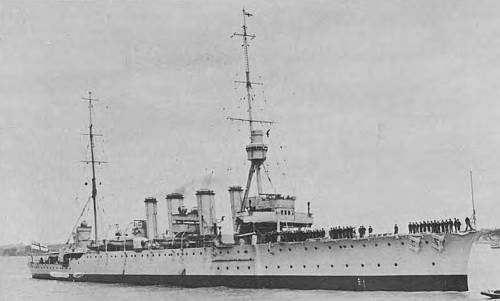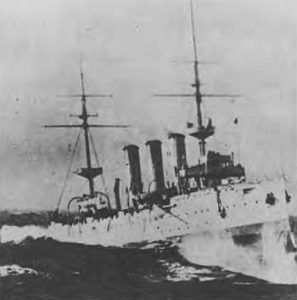- Author
- A.N. Other and NHSA Webmaster
- Subjects
- None noted
- Tags
-
- RAN Ships
- None noted.
- Publication
- August 1972 edition of the Naval Historical Review (all rights reserved)

It was only to be expected that the two countries of Australia and New Zealand would establish naval forces of their own. Not only did their geographical positions dictate this, but there was that link with the Royal Navy which was almost a part of the heritage that their peoples had inherited from the seafaring nation from which they had sprung.
AFTER MANY CONFERENCES had been held, and many reports prepared, the establishment of the New Zealand Naval Forces was authorised by the passing of the Naval Defence Act in 1913, almost on the eve of the outbreak of World War I in 1914. The old protected cruiser Philomel was commissioned as the nucleus of a Dominion naval force and carried New Zealand sailors into battle.
After the clouds of war had cleared away, attention was directed to naval defence, and subsequent to the visit to New Zealand of Admiral of the Fleet, Lord Jellicoe, in 1919, the Government decided to give effect to the Naval Defence Act of 1913, and also to adopt some of the recommendations of Lord Jellicoe.
The Prime Minister, the Hon. W. Massey, informed the House of Representatives that the British Government had offered to the Dominion the choice of the light cruiser Canterbury, an oil burner, or the Chatham, a coal burner.
Mr. Massey said that because of the difficulty in arranging the establishment of storage tanks for oil it had decided to accept the Chatham. A light cruiser of the Town Class, the ships of which had done sterling service during the first World War, Chatham was under eight years old, having been first commissioned in January 1913.
The building of the first five ships of the Town Class had been provided for in the 1908-09 Estimates as an answer to the naval policy of Germany. For some years Germany had continued to build dual purpose protected cruisers which were named after German towns and this had raised some anxiety in Britain, as the last time that a second class cruiser had been laid down for the Royal Navy was in 1901. The original conception of the Dreadnought era had been that there would be nothing between the most powerful armoured ships and torpedo craft.
The ‘Towns’ were hailed as thoroughly efficient, well armed units, providing an effective answer to the latest protected craft building or proposed for foreign navies. Four more vessels of the class were provided for in the 1909-10 Estimates and three more in the 1910-11 Estimates.
It was to this last group of three ships that Chatham belonged. She was laid down at Chatham Dockyard on January 3 1911, launched on November 9 1911, and commissioned in January 1913. The particulars of the last group of ships were as follows:
- Displacement 5,400 tons.
- Length 458 ft.
- Beam 48 ft.
- Parsons turbines built by the Thames Iron Works, developing a total 25,000 hp gave a designed speed of 25.5 knots on 4 screws.
- Armament: 8 6″, 4 3 pdr. (later 1 3″ AA added), 2 21″ torpedo tubes.
- Complement 475-540.
Chatham’s war service included scouting patrols in the Indian Ocean and the Mediterranean and some action at the Dardanelles before returning to the North Sea to serve with the Grand Fleet. At the surrender of the German Fleet in 1918, she was the flagship of the Third Light Cruiser Squadron flying the flag of Rear Admiral A.T. Hunt.
Her proudest moment occurred on October 30th 1914, when she blocked the German Cruiser Koenigsberg in the Rufidji River, German East Africa, and by shellfire forced the German ship to seek refuge higher up the river, where she was later destroyed by the monitors Severn and Mersey.
In preparation for her new role in New Zealand, Chatham underwent a refit at Chatham Dockyard in August 1920, at a cost of £170,000.
The late Captain August Agar, VC, RN, who was then a Lieutenant, had been appointed to Chatham the previous month with the rank of Lieutenant Commander and in his autobiography, Footprints in the Sea, he tells of the trip out to New Zealand. The ship sailed from Chatham Dockyard towards the end of 1920 and made a leisurely trip out through the Panama Canal. Calls were made at San Diego, Acapulco and Honolulu. Capt. Agar says that the long passage across the Pacific was extremely tedious for the crew, as handicapped by being a coal burner the ship was obliged to proceed at her most economical speed which was not more than six knots.
However, she finally steamed into Auckland Harbour on January 26th 1921, and without any ceremony quietly slipped into her berth at Sheerlegs Wharf. (I should point out here that Capt. Agar, who was apparently relying on his memory when he wrote his book, says that they arrived at Auckland just before Christmas Day 1920. This was a bad lapse of memory on his part.)

A short while after the Chatham had berthed Commander Hotham went across to the City on a Harbour Board launch and was welcomed by Commander Williams, naval adviser to the Government, and the Chairman and Secretary of the Harbour Board. Accompanied by several of his officers he then motored to Government House to call on the Governor-General, Lord Jellicoe. The next call was on the Prime Minister, Mr. W. Massey, who had come up from Wellington especially to welcome the ship and was staying at the Grand Hotel. Later in the afternoon the calls were returned. The first to visit the ship was the Governor-General, who offered a formal welcome to the ship’s company and greeted them as shipmates. He was followed by Mr. Massey, who in his address to the assembled ship’s company expressed the hope that many of them would find a permanent home in New Zealand. His hope was fulfilled as it turned out because many of those who listened to him that day did marry and settle down in New Zealand.




